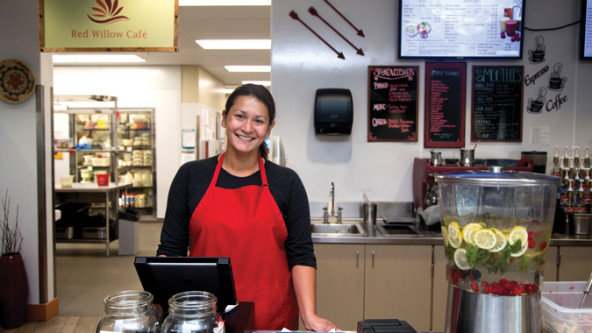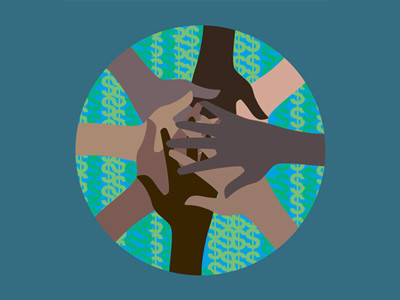 Northwest Native Development Fund provided entrepreneur Theresa Desautel with both a loan and business counseling to support the café she owns and operates on the Colville Reservation in Washington state. (Photo by Uzoma Obasi)
Northwest Native Development Fund provided entrepreneur Theresa Desautel with both a loan and business counseling to support the café she owns and operates on the Colville Reservation in Washington state. (Photo by Uzoma Obasi)
The Northwest Area Foundation tends to think of its investments in Native communities as long-term partnerships. Investments should not only deliver economic returns, but also support cultural traditions and build stronger relationships with communities through impact that lives on for multiple generations.
This sense of cultivating long-term partnerships, honoring the Native communities we serve, grounds our work. It also grounds our funding commitments.

Reversing Centuries of Inequities for Native Communities
There are 75 Native nations in the region we cover, which stretches from Minnesota to Washington and Oregon. Our foundation’s name came from the family of railroad giant James J. Hill. As the railroad sparked economic and demographic transformations across the United States, Native communities continually lost ancestral homelands, wealth, and the opportunity to thrive on their own terms—losses that reverberate today. In other words, our foundation’s assets and the struggles of Native communities are intricately connected.
I would argue that the impoverishment of Indian country is a design feature of the United States—from first contact to the present—rather than an unintended consequence of progress. That is, policies of colonial powers and the US government intentionally pursued enrichment of Europeans and people of European descent at the expense of Native communities through confiscating Native lands and awarding them to non-Natives, committing massacre, introducing disease, or inflicting other traumas. These policies devastated Native economies and, more importantly, denied Native people their very right to exist. Systemic inequities continue to this day. Native people have battled the odds to overcome centuries of oppression, and to find ways to thrive and prosper—usually with little or no support from broader society.
Through our funding, we aim to acknowledge the inequities facing Native communities and recognize that those communities deserve much better. We support solutions to economic challenges led by and for Native communities, because we honor the right of Native people to control their own futures. Native people know their communities better than anyone else, and they’ve been building their own solutions for centuries, long before foundations like ours existed. Back in 2012, we chose to encourage more funding for Native communities by making a formal commitment to award 40 percent of our grants to Native-led nonprofits. The commitment was a way to lead by example and hold ourselves accountable, which we couldn’t do unless we tracked and measured our performance. We’ve met that commitment every year since.
Yet our own funding is only a drop in the bucket. We’d love to recruit more like-minded funders, because Native communities continue to fly beneath the radar. A 2018 report from First Nations Development Institute shows that only 0.23 percent of philanthropic funding goes to Native communities, although Native people constitute two percent of the US population and experience a disproportionate level of need.
This tendency to overlook Native people also persists among mission investors. In fact, we haven’t even been able to find a study on Native funding through mission investments despite strong demand for capital in Native communities. A report from the Minneapolis Federal Reserve’s Center for Indian Country Development, for example, showed a $48 million gap in financing needs among Native communities in 2017.
Native CDFIs: Proven Allies for Meeting Capital Needs
A number of our grants and mission investments support Native community development financial institutions (CDFIs), and for us, these investments have been transformational. Funders looking for opportunities to support Native communities should learn more about them.
Native CDFIs are founded and led by Native people, and located in Native communities. They provide loans, financial assistance, education, and training for Native entrepreneurs and businesses—and they do so with the utmost cultural competence. They also play an essential facilitation role as a trusted investment partner. Their financial knowledge and strong connections to the local community and Native culture allow them to open up pathways between their economies and outside resources. This truly unique expertise has led to a very successful track record of helping businesses and entrepreneurs rooted in tribal economies grow, generate jobs, and cultivate fertile ground for further investment.
Indeed, Native CDFIs “can make connections between individuals and financial institutions, and find creative ways to keep those relationships working,” says Ted Piccolo, a member of Colville Confederated Tribes, and executive director of Native CDFI grantee and PRI recipient Northwest Native Development Fund.
Northwest Area Foundation currently has active grants with 18 Native CDFIs, totaling more than $10 million, and three mission investments, totaling nearly $2 million. We believe these investments represent a special opportunity for long-term impact because they not only help meet capital needs, but also feed the self-determination of Native communities. As Piccolo says, “We’re dedicated to the dirt, dedicated to our land and our culture … What it means is, we’re not going anywhere!” We wholeheartedly support this kind of multi-generational thinking.
Using Program-Related Investments as Mission Investments
Our three mission investments in Native CDFIs are program-related investments (PRIs), which we define as below-market-rate investments that prioritize impact over financial return. Our PRIs come directly from our endowment, just like our market-rate mission investments and other forms of investing. This is unlike many foundations, which draw their PRIs from grants budgets. So if we lose money on a PRI, our endowment absorbs the loss without reducing our available budget for grantmaking.
But we haven’t lost money. Despite a few, isolated losses on individual PRIs, we’ve emerged from 14 years of making PRIs to Native and non-Native recipients with a small net profit.
Importantly, all our PRIs are part of a revolving pool of loan funds that offers below-market-rate loans to Native CDFIs at 1 to 3 percent interest, which helps to cover any losses. Our low interest rate also allows the Native CDFIs to charge low interest rates to customers, while still yielding earnings that can cover their expenses. The PRIs also boost the amount of lending capital that Native CDFIs can report on their books, which then attracts more capital from other investors. As we get repaid, we can lend the money to other Native CDFIs. These criteria for PRIs—along with others, such as flexible loan terms and small loan sizes—foster long-term partnerships that provide capital to the people who need it most.
How a Grant and a PRI Facilitated a $10 Million Capital Pool
One inspiring example of this approach comes from First Nations Oweesta Corporation, a national Native CDFI intermediary and a true leader in helping grow the field over the last decade or two.
We’ve awarded a number of grants to Oweesta during the past several years, including a recent grant of $1 million to seed a $10 million capital pool. Oweesta is using the pool for relending to a group of Native CDFIs so that those organizations can build their capacity to receive loans from other investors. It’s the first pool of this size created for Native CDFI lending capital that’s not funded by the federal government.
Alongside the grant, we’ve provided a $500,000 PRI, which allows Oweesta to continue lending to smaller and still-emerging Native CDFIs outside the capital pool. Oweesta estimates that relending activities will yield 3,000 jobs and 120 units for affordable housing through loans to 900 small businesses.
Chrystel Cornelius, Oweesta’s executive director and member of the Ojibwe and Oneida tribes, told us that the investments increase the organization’s “ability to promote progressive job creation opportunities, infrastructure development, and advanced homeownership options for thousands of tribal members.” The effort is led by Native CDFIs for other Native CDFIs and for creating opportunities that align with the values of self-determined Native communities.
A Pattern for Long-Term Partnership
The funding for Oweesta typifies a pattern of integrated practices we’ve found effective. We award PRIs that complement grant funding and increase access to capital that circulates through Native communities. This allows Native CDFIs to expand and serve more community members, and it provides financial and social returns that they, and we, can grow and spread for the future.
For us, the importance of this approach lies not just in supporting Native communities or raising their visibility, but also in partnering with Native communities for the long term. The inequities Native communities face today unfolded over the course of centuries and are rooted in exclusion. Reversing them requires that we embrace approaches centered around relationships and led by Native people. We need to be humble and flexible funders.
Piccolo expresses this idea in very sensible terms: “In our communities, there’s no shortage of entrepreneurs and no shortage of creative energy. Sometimes, all you need is the right kind of partnership to help that energy take shape.” We are learning our way into that kind of partnership.
Support SSIR’s coverage of cross-sector solutions to global challenges.
Help us further the reach of innovative ideas. Donate today.
Read more stories by Kevin Walker.

